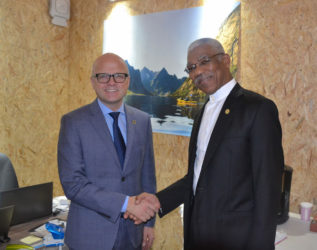Guyana has agreed to issue a plan early next year detailing its clean energy transition including a “facts-based consideration of the Amaila Falls Hydropower Project (AFHP) and all other possible renewable energy options”.
This commitment is contained in a joint statement by Guyana and Norway following a meeting held on November 16, 2016 on the sidelines of the climate summit in Marrakech, Morocco.
A report on the final review of the feasibility of the controversial Amaila Falls Hydropower Project had been due in September this year but it has been delayed because the Norwegian contractor, Norconsult requested more time. The meeting in Marrakech between the two countries is grounded in the forest protection deal which had been signed between Guyana and Norway in 2009 under which Oslo pledged a maximum of US$250m over five years if various benchmarks and commitments were met. This agreement has since been extended and will be up for renewal.

Observers say if the government is to present a clean energy transition plan early next year, much work will have to be done. In the last few weeks heavy fuel oil generators have been ordered for Anna Regina, Bartica and other areas where Guyana Power and Light has experienced generation issues. Guyana’s advocacy of a Green state and clean energy is at odds with the ongoing resort to hydrocarbon-based generators. In addition, the APNU+AFC government has made little headway over the last 18 months with clean sources of energy such as wind and solar farms. Plans for small hydropower projects have also not taken off. Many questions have been raised about the feasibility and cost of the AFHP and if that project is nixed in the Norconsult review there won’t be an immediate platform for clean energy.
The joint statement yesterday said that President David Granger and Norway’s Minister of Climate and Environment Vidar Helgesen had “very constructive” dialogue on the way forward for their forest and climate partnership.
The statement pointed out that the cornerstones of the Guyana-Norway partnership are to safeguard Guyana’s rainforest, improve forest governance and support the country’s holistic green development.
Granger outlined a holistic vision which included ambitions in the areas of climate mitigation, coastal zone management, conservation, renewable energy, biodiversity management and eco-systems management.
“My administration is committed to the establishment of the ‘green’ state and creating the institutions and the governance structures to ensure that we achieve the Sustainable Development Goals (SDGs) in the shortest possible time. I am pleased that the dialogue with Norway is advancing,“ he said, according to the statement.
The meeting confirmed that Guyana has kept its deforestation rate low since the beginning of the partnership, is making good progress on agreed forest governance reforms and is pursuing a variety of clean energy solutions.
The statement quoted Helgesen as saying, “I am very impressed that President Granger’s government has decided to embark on a green economy pathway, including its commitment under the UN Climate Change Convention to eliminate its dependency on fossil fuels and move close to 100 percent renewable energy supply by 2025. We are proud to work with Guyana to realise its green economy vision, maintain its deforestation rates as one of the lowest in the tropics and strengthen forest governance, as well as its commitments to a green energy transition”.
The two countries agreed to continue dialogue on how to develop their partnership in the 2020-2030 period.
Guyana and Norway had agreed in Paris, France, in December 2015 to conduct a review of the Amaila project’s current financial model, which the government believes could shackle many generations of Guyanese to debt. Both sides also agreed on Norconsult for the undertaking of the analysis.
The two countries are awaiting the study to make a definitive decision on how to proceed. The AFHP was the flagship project of the five-year forests protection partnership between Guyana and Norway in which Guyana could earn up to US$250 million in performance-based payments based on an independent verification of Guyana’s deforestation and forest degradation rates and progress on REDD+ enabling activities.
The partnership has been extended so that Guyana can fulfill some of the remaining deliverables.
Norway had transferred US$80 million to the Inter-American Development Bank for the project but the David Granger administration has said that as currently configured, “it would not only be irresponsible, but a downright criminal act of deception,” if government proceeded with Amaila.
Norway had previously urged the APNU+AFC administration to consider the merits of the AFHP and indicated that Guyana stands to lose the US$80 million earmarked for the project if it fails to come up with a plan for “transformational” renewable energy sources that can be realised in the next few years.
Subsequently, both sides agreed to a final, independent review of the project.




